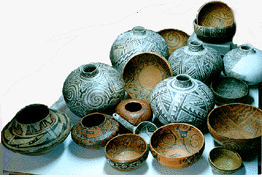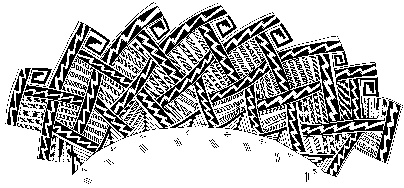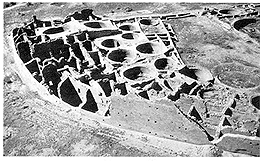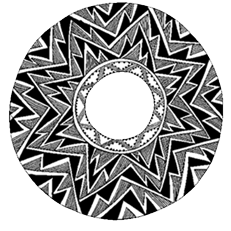Anasazi
Pottery Restoration and Conservation 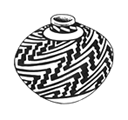
|
When the issue of restoration or repair comes up, conservators raise red flags when someone not trained is doing the work. Native Americans are sensitive to their ancestor's art and there frequently is a spiritual quality when these first Americans view, appreciate, and relate to other people about Anasazi pottery. This pottery is more than an art form, it truely is material culture. Preservation and analysis of the ceramic is done by applying several disciplines. These artifacts involve several archaeological issue that entails several levels of science and research. Food residue analysis, carbon testing, pollen analysis and counts, as well as geological characteristics in the matrix or soil where the ceramic was interred are all taken into consideration. A view of the ceramic and its time period is considered through multidisciplinary data is generated. This is all lost if archaeology and its many facets are not part of the process when the ceramic is recovered. Conservation and restoration of ceramics is keyed to several levels of analysis:
These ceramics, as are all low fire ceramics, are very delicate and the paints are often attenuated or easily removed by washing or sanding and many other procedures during the restoration process. A virtual nightmare when we consider the art and surface survived about a thousand years just to be damaged and frequently over-painted by the person "restoring" the artifact-ceramic. When working on any ceramic and especially these archaeological artifacts, we need to respect them as historical survivors and diligently work at not distressing them further. Preserving the past is our priority. Archaeological illustrations are done to focus or study the original art in its original form. We first do a technical one to one drawing in direct compliance with The Guide to Archaeological Illustrating second revised edition, by Brian D. Dillon. Then a one to one graphical reconstruction of the ceramic/artifact is created on paper and another sheet of mylar with rapidograph pens and ink. The comparison of the original and reconstructed drawings allows for more accuracy because the rhythms, patterns, and idiosynchrasies are studied and duplicated.
This sample's size is 5% of the original and much of the detail is lost, but you can see the entire pattern. This completed form makes it possible to appreciate the entire painted surface of the object at a glance. They are technically very accurate and quite beautiful! The best compliment to the artist's hand or the finish artwork in the form of these restorations or inkings is not being able to determine interpretation or bias from the artist in the disciplined pursuit of a true representation of the original work. (50% sample prints are 27.5" X 14" ) Anasazi pottery is the material culture of a very prolific people who are probably the Pueblo people in New Mexico today. The Anasazi is a name of a past people and a cultural period in Native American Indian history that lasted from about 800-900A.D. to 1200-1300A.D.. There is evidence that these people were very well organized as extended groups that had contact with each other and would trade, intermarry, and war with each other or invaders.
Chaco canyon's Pueblo Bonito was likely a ceremonial center. Extensive roads from all over the southwest led to Pueblo Bonito illustrating how extensive the trade routes were. Parrot skeletons and a wide array of pottery traded in and found at Chaco indicate Native Mexican Indian populations traded with the Anasazi and many other groups of the period came together for rituals, planning, and they may have had a very extensive government or network of communications and material support when there were food shortages. The quantity of kivas at Chaco indicates a ritual site even if there was or was not a permanent population living there. Richard Wetherill used to have his ranch house beside Pueblo Bonito at Chaco and he used his land for cattle, but in the process discovered the many ruins in the area of Mesa Verde. Mr. Wetherill talked with the Navajo and they had many festivals, celebrations, and he even took sick Navajos into his home to nurse them back to health when they were close to death from pneumonia. He was privileged to hear some of the Navajo oral traditions and how they may have related to the Navajo's past and they may have intermarried as well as made war with the Anasazi: "Anasazi, said Richard (Wetherill), was a Navajo word. The Navajo used it to describe the ancient people, now vanished, whose ruined dwellings the Navajo found when they migrated into the Four Corners region from the northward. In a loose, vague sense Anasazi meant ancient enemies. Richard did not know if this implied that the first of the Navajos had found some of these early ones still in their pueblos and cliff dwellings, and made war upon them." (McNitt, Frank. Anasazi. Albuquerque: University of New Mexico Press, 1991.) In many of the Anasazi sites spread all over New Mexico, Arizona, and southern Colorado there are many shared attributes even though each area and style type is distinct.
Mesa Verde has a very distinct type of pottery that we can compare to Pueblo to Pueblo, as are membres styles and attributes from San Juan Basin types. There are many qualities that allow identification based on attribute analysis. The core material and coil method of construction, the polished slip or "tierra sigilatta" coating and the painted surfaces allow for material analysis and origin correlations as well as dating implications. Many elements are now considered besides the artistic qualities that went into creating the classic Anasazi black on white and polychrome dough bowls or grain storage ollas, and many dipper, mug, pinch bowl, and canteen variations. Every detail or attribute must be analyzed and then shards are compared and associated and aligned to design elements to reconstruct each vessel. I consulted the museums and other restorationists, conservators, and the literature. Then I proceeded to work years with field experienced graduate student archaeologists from The University of New Mexico as a large amount of ceramic material turned into dozens of vessels. I collected all the available literature and consulted the conservation institute in New York, several conservators, and conservation supply companies to learn as much as we could before ever starting. After four years of work and research the product we produce is superior to what we have found in the limited restoration market or available services in several ways.
|
